|
When polled on the question, “How many in the audience have fuel odors in their C1?”, the count was in the 80 percentile. The remaining 20 % may not drive their cars. This is a common issue as the fuel tank is located in close proximity to the passenger compartment. The fuel tank is reached by opening the cover behind the seat and lifting the soft-top out (if you have one) and removing the fiberglass panel exposed when the top is rotated up out of the cavity. Removing the panel is accomplished by removing all the screws around the panel and lifting the panel out. In some C1’s the seats may have to be removed, loosened or just slid forward. Personally (webmaster), I can get access to the screws by just removing the back cushions on my ’60.
Chip Werstein did a great job discussing the aspects/sources which must be addressed on the fuel tanks to eliminate odors. First, obtain all the listed items when attacking the fuel odor problem prior to beginning this “restoration” and you can most-likely complete the entire task in a day. If you don’t obtain the items, you will spend a lot of time looking for parts and your car will be down the whole duration.
|
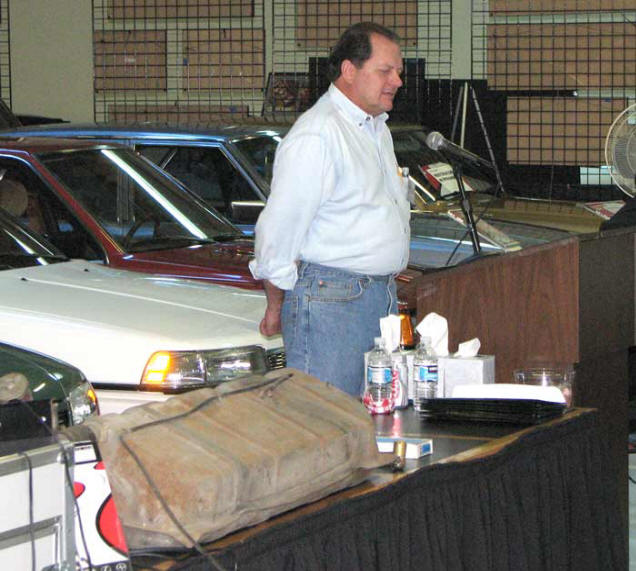 |
| Above, Chip addresses the fuel tank issues while sitting alongside on the table is a C1 fuel tank. For this write up on Chip’s subject, your webmaster has taken pictures of his car as an example to further explain the issues discussed. Also, since I have replaced several of these components some editorial liberty’s were added. |
Pre-Purchased Items:(Note: Webmaster has listed part numbers from Corvette Central (CC) only because I had a CC catalog in front of me. Many of these parts are the same from other vendors. At least you can find what they look like in CC’s catalog)
1. Tank Vent Rubber Tubing, 57 to 62, CC#361114, approx $9, (if purchased locally, always use gasoline rated rubber)
2. Fuel Filler Tube (hose clamps might be optional, many times these are reuseable), CC #361112 tube w/clamps, approx. $20.
3. Fuel Sending Unit gasket (cork preferred, rubber will creep/flow when clamped), CC lists a gasket but I am not sure of the material, CC #361109 approx. $5.
4. Fuel Filler Tube Grommet (located and visible in filler compartment), 53 to 62, CC#361113, approx $9
5. Tube for venting/draining Fuel Filler Compartment, 56 to 62, CC#361020, approx. $5
6. 10-32 Screws for fastening fiberglass panel in soft top compartment, purchase at Home Depot.
7. J-Nut and screws for rear part of fiberglass panel in soft top compartment (CC screw set (56 to 61) #341110, (61L to 62 #341111).
8. Sealing Strips for placing between panel and body when installing tank fiberglass panel (CC Strip Caulk, 53 to 62, #281125), approx. $8.
9. Fuel sending unit pickup strainer, 53 to 62, CC #362209, approx. $10
Optional Items, if interested & YOU MAY NEED them:
1. Steel Gas Tank, 57 to 62, vented, CC #361004 $220 (Personal experience locally, it cost approx. $200 to have your gas tank renewed).
2. Gas Tank Fiberglass Cover, 56 to 62, CC #361003 approx. $140.
3. Fuel level Sending Unit, 56 to 61E, CC #361107, 61L to 62, CC #361108, approx $70
4. Fuel filler neck (Metal), CC 55 to 60, #361015, 61 to 62, CC#361016, approx $50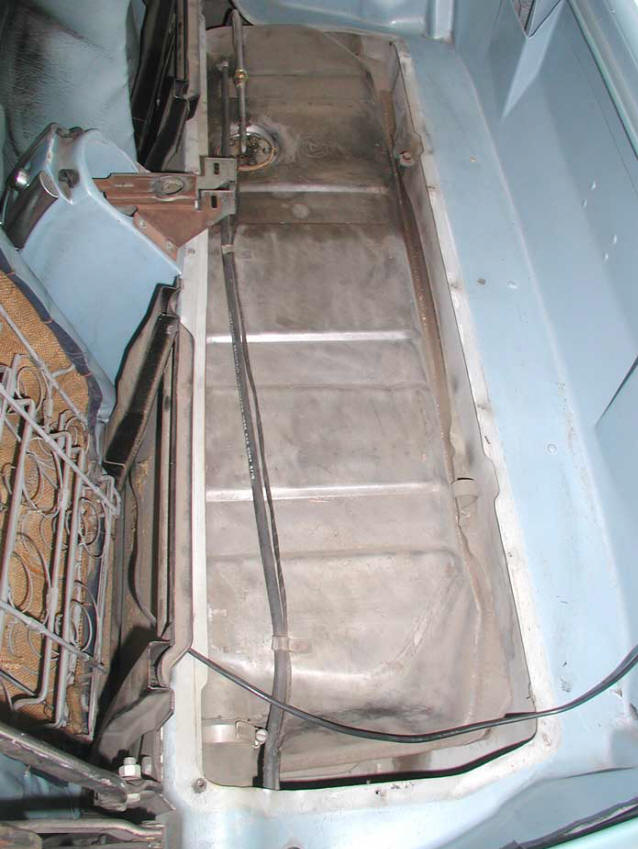 |
|
| The picture above is the entire fuel tank after removing the panel cover. This is a ’60 car and panel screw access was available by removing the seat back cushion and moving the frame forward (normal sliding adjustment). The forward screws are 10-32 machine screws while the ends and the rear screws are J-nuts with associated screws. Visible at this point is the fuel level sending unit, fuel tank vent line, one end of the fuel filler tube (w/clamp), fuel sending unit electrical wires and the fuel supply line exiting the top of the photo. The remaining black wire crossing the tank was for my CB radio. |
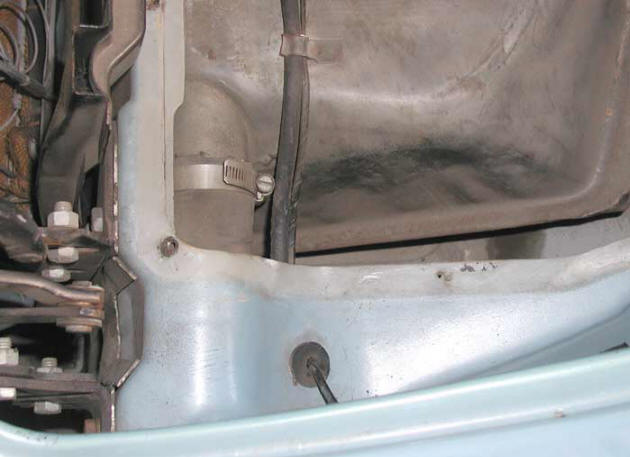 |
| Above is the fuel filler hose with one clamp that attaches the filler to the tank. This clamp can be tightened while the one hidden at the other end of the hose is near impossible. |
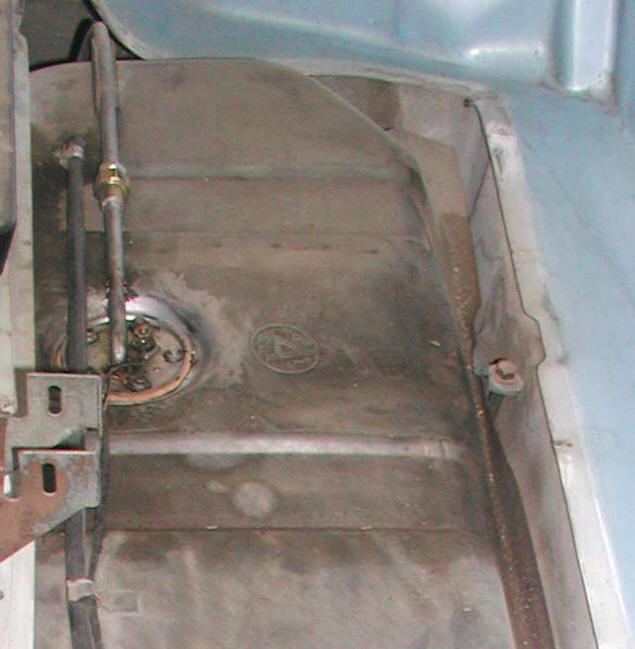 |
| Opposite of the filler end of the tank is the fuel level sending unit and it can be seen that the fuel supply line to the engine exits on the passenger side of the car. Note the stains from past fuel leaks, or seeping from the sending unit. To the rear of the tank a bolt head is visible. This bolt (one of four) secures two straps which hold the tank in position in the car. |
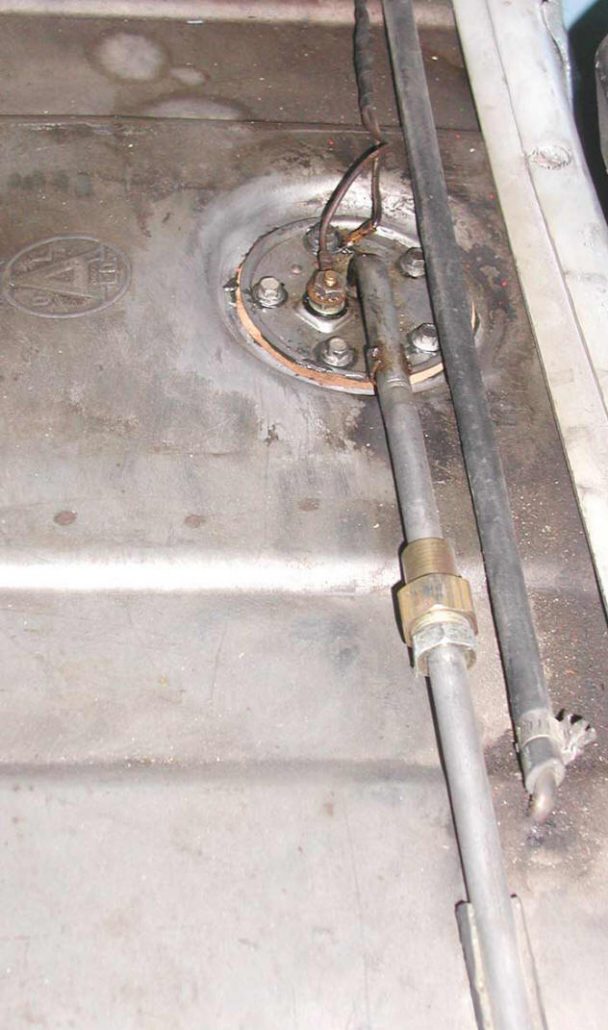 |
| A closer view of the sending unit from the passenger side of the car. Note that the fuel supply tube extends and is part of the sending unit. Inside the tank, this tube has a screen (not visible unless you remove sending unit) slipped over to prevent particulates from entering the fuel line. If your fuel level gage is inoperable or inaccurate you might consider replacing the sending unit at this time. Save the mounting screws (hex head flanged) and replace if in good condition. Sometimes slotted or Philips screws come with the replacement but the hex head is correct and easier to tighten. Another item, from the above picture, is the electrical wires attach to the center of the sending unit (from fuel gage) and a ground which attaches to a mounting screw. The tapped holes mounting the sending unit are “thru” holes, i.e., the screws must be sealed or fuel will seep/wick up and you will have a fuel odor. Small o rings sometimes come with the sending unit and some installers put a small amount of Form A Gasket on the screw threads when installing.
The Corvette vent tube connection is a slip fit and pressure clamp. This is the tube which extends over to the drivers side fuel filler compartment.
The fuel supply line is connected to the line exiting the tank area (note rubber under supply line to prevent vibration noise) to under your car and forward toward the engine along the frame. The picture below shows the fuel line as viewed forward of the rear passenger wheel. As is obvious, there is another fuel line connection visible and the fuel line is protected from damage with a outer “spring-type” wrap. This prevents damage from flying debris near the rear wheel. |
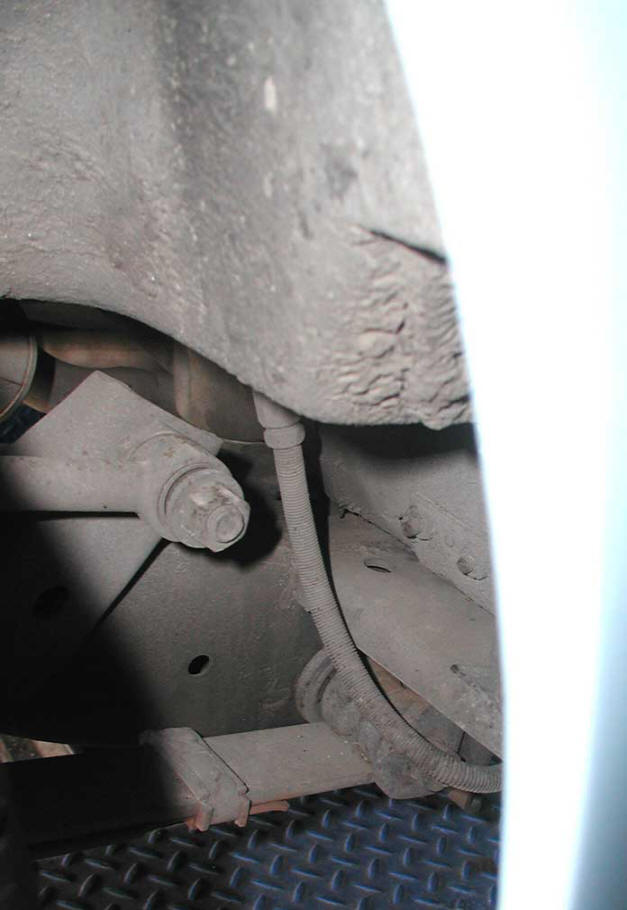
 |
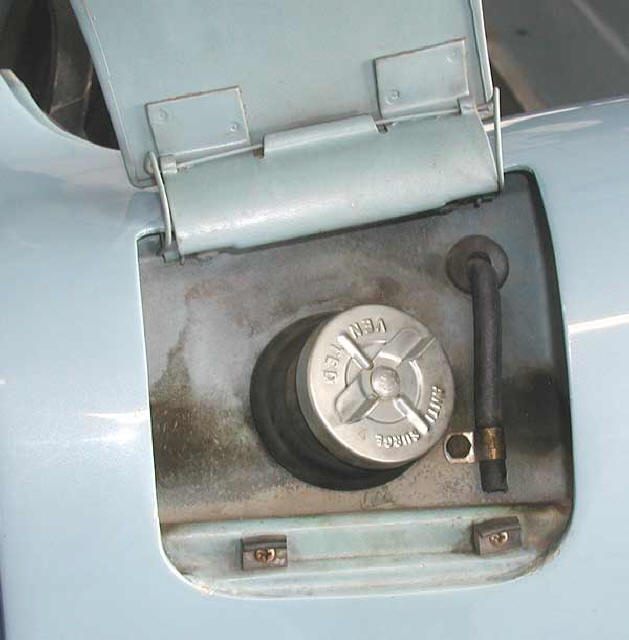 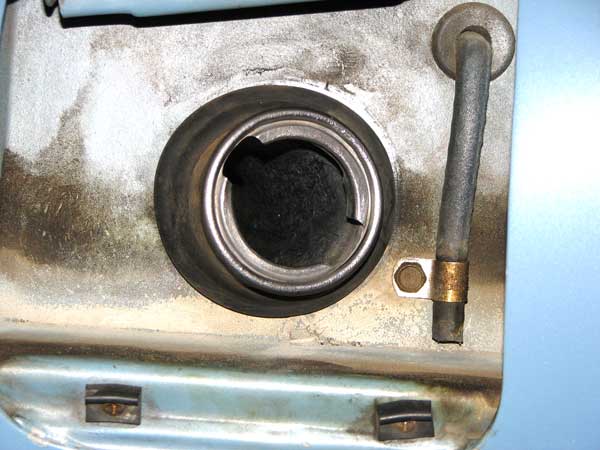 |
| The above picture is the gas filler door area. Cars that are pre-61 have doors that open vertically while the ’61 and ’62 are hinged on the left side. Another difference is the end of the vent tube (from the gas tank vent) on the ’61 and ’62 extends horizontally from the hole above and travels over toward the hinged area of the door. The correct gas filler caps after 1956 were sealed caps and not vented (the tank is vented). Non vented caps are difficult/expensive to locate and clearly I have the wrong one. After 1956 the tanks were vented negating the use of a vented cap. CC does sell a 53 to 62 (replacement cap) with Anti-surge Venting. The black area around the filler neck is a grommet which is listed in the parts list above. If the filler neck tube is replaced, the grommet might as well be replaced. Other items on the list are the vent hose and its associated grommet. When the gas cap is removed, inspect the surface of the filler neck for damage (this part can be replaced also and is listed above) and make certain that the cap rubber gasket is good and the cap tightens down tight. The rubber fuel door bumpers can be replaced/installed at any interval. |
Another item to inspect and many do not know this exists (including me), is the vent hole located below the gas cap. This vent hole is not very visible in the upper pictures but the hole will allow spillage to drain out of the compartment.
A rubber tube slips on the nipple/protrusion on the underside and extends down and under the car. Otherwise the spillage will drip into the passenger compartment.Sometimes the gas cap blocks the view of this hole, but it is there.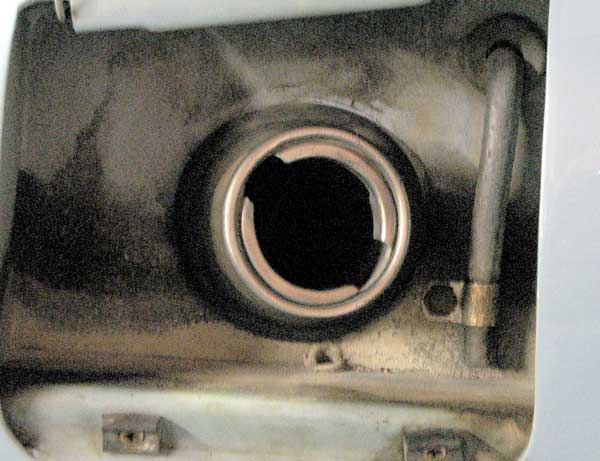 |
Webmaster Testimonial:
I determined that the rubber drain tube was missing which drained the spillage out of the gas filler area in my ’60 so I set out to install a drain. I did this task without removing or loosening the tank. It does make it more difficult and it helps if you have skinny arms.
1. I removed the gas tank fiberglass cover from the soft-top compartment. This exposed the fuel tank filler rubber connection between the filler pipe and the fuel tank. Loosen the clamp attaching the tube to the tank. The remaining clamp usually cannot be seen or accessed.
2. Remove the gas cap. Remove the filler tube grommet. If you have a replacement this is simple, cut it. I wanted to save mine and squirted WD-40 on it and this makes is slide on the tube. Once the grommet is pliable and rotates, slid it off or rotates sufficiently to remove it. Rotate the filler neck and disconnect the rubber tube connecting the filler tube to the tank. WD-40 and a prying screwdriver can assist here also. I also wanted to save this tube so I was careful.
3. Removing the filler tube through the hole in the gas filler area is usually not possible because of the size of the head on the remaining clamp. I pushed the filler assembly down into the cavity next to the tank and removed the remaining clamp. The whole assembly is easily removed through the filler area hole when this is done.
4. Slip the rubber drain hose over the nipple of the hole for draining gas spillage. With the gas tank installed this is not easy to get you hand underneath to push the tube on. I believe, there is a sharp protrusion on this nipple which assists in retaining the tube once slipped over the nipple. Again, WD-40 helps slide the tube on. Make sure the tube is long enough to extend through a hole underneath the tank area and allow the spilled fuel to drain out.
5. Reversing the above order of assembly will complete the job. When installing the fuel filler tube assembly, make sure the hose clamp on the filler tube side is tightened prior to slipping the tube on the gas tank because the inner clamp is not accessible.
 Leaving the grommet off while assembling the filler tube also makes the process easier. This grommet (with a WD-40 application) will slip over the gas cap end of the tube. Reinstall the gas tank cover as outlined above.
Leaving the grommet off while assembling the filler tube also makes the process easier. This grommet (with a WD-40 application) will slip over the gas cap end of the tube. Reinstall the gas tank cover as outlined above. |
| Chip’s Recommended Fuel Odor Elimination Procedure:
It is recommended that you perform this procedure with as little fuel in the tank as possible.
1. Preparation: Purchase the parts list identified at the beginning of this article. Some of the visible items (gas filler cap surface, gas filler metal tube, gas cap and others can be inspected prior to parts purchasing). If fuel gage is operating correctly, you may not need to purchase a new fuel level sending unit, however, do obtain a new sending unit cork gasket. You might want to also purchase the screen for the sending unit pick up as they do deteriorate. You will most likely pull the sending unit whether you use your existing or purchase a new one.
2. Begin by removing the fiberglass panel in the bottom of the storage compartment (behind the seats). Clean any sealant existing on mating surface between panel and car body. |
| 3. Inspect areas discussed earlier (fuel supply line, sending unit mounting surface, fuel filler tube connection) for obvious fuel leaks/seepage. |
| 4. Spray some type of rust remover lubricant on the gas tank hold down straps bolt threads that are securing the fuel tank. Let sit for a comfortable duration where you feel comfortable in removing/loosening these bolts. Don’t force the removal, the fix to the fixed nuts is a Big Job! |
| 5. Remove/Loosen the exposed clamp on the gas filler tube shown above. In order to separate the filler tube and tank, the hold-down straps should be loosened and the tank moved toward the passenger side of the car. The fuel supply line on the tank top must be disconnected in order to “move not remove” the tank. Hint: Use a board on the drivers side to “pry/nudge” the tank over to disconnect the fuel filler tube. Remove the gas filler metal neck, grommet and tube separating it from the gas tank (the remaining clamp will most likely hold this assembly together). These parts should come out through the gas filler door compartment. |
| 6. Remove the electrical connection at the center of the sending unit. Remove the screws securing the sending unit to the tank (one screw contains the ground wire). Remove the sending unit. Turn each screw slowly and spray rust remover in necessary so a NOT TO TWIST OFF A SCREW. Another fix you don’t want to do. |
| 7. Inspect the sending unit float, corrosion under the sending unit, and the screen at the end of the filler tube. This is the decision stage to decide on installing a new sending unit unless you already purchased a unit. Clean the mounting surfaces of the sending unit and tank. Avoid particles from dropping into the tank. |
| 8. Using a flashlight inspect the inside of the tank. Decision Point: If cleaning the tank is needed, it can be removed and brought to a fuel tank restoration/radiator shop to be boiled out. Depending on the amount of contamination and/or damage, reproduction tanks are available (see list above). |
| 8. Tank removal requires removing the hold-down straps.
9. Install the vent tube which extends from the gas filler compartment and properly route it under the car.
10. Relocate the tank back into its proper location and tighten the hold-down straps. |
| 11. Sending unit reassembly: Prior to inserting the sending unit into the tank top, “chase” out the threads used to mount the tank. Sometimes these holes are gooped with sealant and installing these small screws cannot take a lot of torque. Take care to capture any particles by placing you hand or something inside the tank under the screw hole being chased. Insert the sending unit containing a good screen into the tank. Don’t forget to slip the new cork mounting gasket on first. Using a light coating on both surfaces of the gasket set the sending unit on the tank surface and install a screw (temporary). This will secure the unit while checking that all the screw holes line up. Continue to install the mounting screws remembering to put on the small rubber seals on each screw and some thread sealant on the threads. |
| 12. Tighten the sending unit screws using a nut-driver for hex head screws. Remember to locate the grounding lug underneath the correct mounting screw. Place the fuel gage electrical wire on the center of the sending unit. Reconnect the engine fuel supply line. |
| 13. Install a new rubber vent line by slipping tube over the fuel tank vent and install clamp. Route this vent line over toward the gas filler compartment and “properly” insert it through the body with a grommet. |
| 14. Assemble the New/Old metal filler neck and new filler neck tube (on the work bench) and tighten the metal clamp. Remember that this clamp has no access when installed. Slip grommet over the filler neck. Feed the filler assembly through from the outside of the filler compartment down to the tank. Prior to slipping the filler tube on the tank, install the tank side tube clamp, loosely. After slipping the filler tube on tank, tighten the clamp. |
| 15.Prepare to install the upper fiberglass tank cover panel. Chase the threads on all 10-32 captured screws and install J-nuts where used. |
| Chip Says,
“IF you do this process properly, as outlined, and carefully, you should not have gas odors”. |